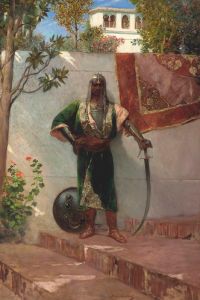
The Serbian Concubine
A hand-painted replica of Jean-Joseph-Benjamin Constant’s masterpiece The Serbian Concubine, meticulously crafted by professional artists to capture the true essence of the original. Each piece is created with museum-quality canvas and rare mineral pigments, carefully painted by experienced artists with delicate brushstrokes and rich, layered colors to perfectly recreate the texture of the original artwork. Unlike machine-printed reproductions, this hand-painted version brings the painting to life, infused with the artist’s emotions and skill in every stroke. Whether for personal collection or home decoration, it instantly elevates the artistic atmosphere of any space.
Jean-Joseph-Benjamin Constant's painting The Serbian Concubine is a notable work by the French academic painter, who was active during the late 19th and early 20th centuries. Benjamin-Constant was renowned for his Orientalist themes, which were inspired by his travels to North Africa and his fascination with the exoticized depictions of the East that were popular in European art during his time.
The Serbian Concubine depicts a scene that aligns with the Orientalist tradition, characterized by its romanticized and often idealized portrayal of life in the Ottoman Empire or other Eastern settings. The painting features a woman, identified as a Serbian concubine, reclining in an opulent interior. The setting is richly detailed, with luxurious fabrics, intricate patterns, and a warm, glowing palette that emphasizes the sensuality and exoticism of the scene. Such elements were hallmarks of Benjamin-Constant's work, reflecting his skill in rendering textures and creating atmospheric compositions.
While the title of the painting suggests a specific cultural and historical context, it is important to note that Orientalist art often blended fact and fiction, and the scenes depicted were not always accurate representations of the cultures they purported to portray. Instead, they were shaped by the European imagination and the tastes of the time. The term "Serbian concubine" in the title may refer to the historical practice of concubinage in the Ottoman Empire, where women from various ethnic backgrounds, including the Balkans, were sometimes part of the imperial harem. However, the painting itself does not provide specific historical details or context about the subject's life or identity.
Benjamin-Constant's work, including The Serbian Concubine, was well-received during his lifetime, and he exhibited regularly at the Paris Salon. His paintings were admired for their technical mastery and their ability to transport viewers to distant, imagined worlds. Today, his works are studied as part of the broader Orientalist movement in 19th-century European art, which has been the subject of critical re-evaluation for its role in perpetuating stereotypes and colonial attitudes.
The exact date of creation for The Serbian Concubine is not widely documented, and detailed information about its provenance or current location is not readily available. As with many Orientalist works, the painting reflects the artistic and cultural trends of its time rather than a precise historical narrative.

















